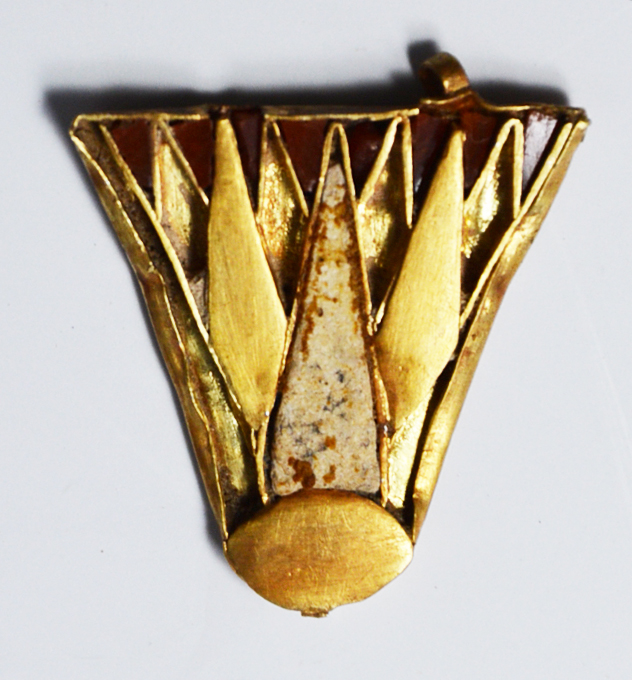Krásný kousky, dobré počteníčko 
Luxury grave goods from around the known Bronze Age world found in Cyprus
Categories: Treasures , Nálezy nejenom s detektorem v západní Evropě
Archaeologists in the Cypriot town of Hala Sultan Tekke near Larnaca have uncovered a two-chambered tomb from the Late Bronze Age. The tomb dates from 1400 to 1300 BC. It contained a rich assortment of more than 500 pieces of imported luxury goods made of gold, silver, bronze, ivory, precious stones and richly decorated vessels from many cultures across the Mediterranean, the likes of which have never been found in Cyprus before.
The former Late Bronze Age city of Dromolaxia Vizatzia has been explored for decades. It was a place with a thriving ceramics and textile industry. The vast amount of shell of the nucleus ostracus confirms that it was a production centre for the popular and highly prized indigo blue dye, later knownknown as "Tyrian purple", worn only by the highest-ranking elite as a symbol of superior social status.
Gothenburg University archaeologists from The Söderberg Expedition team discovered the tombs in 2018. The first seasonal excavation uncovered 13 skeletons from two chambers. The grave goods consisted of locally made vessels, jars, alabaster, small jars and baby bottles imported from the area around the Aegean Sea. The most notable of these was a large Mycenaean crater (a vessel for mixing wine with water) with two chariots drawn by four horses and 10 men with swords painted on it. The faience and alabaster vessels were imported from Egypt, as were the perforated ivory discs that were part of the deceased's clothing.
The find required careful excavation work, as the skeletons were very fragile after spending more than 3,000 years in the salty soil around the Larnaca salt lake. Four years after the discovery of the two-chambered tomb, archaeologists uncovered the skeletal remains of 142 more people, for a total of 155 individuals, some of whom were cremated. The bones and tombstones were stacked on top of each other, proving that the tombs had been used for generations.
Hundreds of other rare artifacts were also found, including a bronze knife with an ivory handle, silver and bronzejewellery, Sardinian tableware and a large Minoan hollow bull figurine, the first of its kind ever discovered in Cyprus. At least three large female figurines with bird heads have been discovered. They all have holes in their ears and earrings - one with three ceramic and one bronze, another with three ceramic and the third - the largest - with only one earring.
Another exceptional find is a cylindrical hematite seal from the Old Babylonian Empire. It dates from the 18th century BC, which means that it was already an antique and at least 300 years old when it was placed in the tomb. The seal depicts a deity, people and animals and has a three-line Akkadian inscription depicting the Mesopotamian deity Amurra and two kings, father and son.
Egypt was represented by gold jewellery - mainly a diadem, a beaded necklace, a lotus-shaped pendant with a stonem and faience inlay, and a scarab with engraved hieroglyphics, dating from the reign of Akhenaten and Nefertiti. Also the remains of a fish from the Nile valley found among other animal bones. The precious stones found in the tomb represented, for example, red carnelian from India, blue lapis lazuli from Afghanistan and amber from the Baltic region...
"The finds suggest that these were family tombs for the city's ruling elite. For example, we found the skeleton of a five-year-old child with a gold necklace, gold earrings and a gold tiara. This was probably a child from a powerful and wealthy family," says Professor Peter Fischer, who led the excavation. "We also found a ceramic bull. The body of this hollow bull has two holes: one on the back to fill with liquid, probably wine, and one near the nose to drink from."
The exceptional geographical extent and quality of the tombstones attest to the pivotal role that Dromolaxia Vizatzia played in Mediterranean trade networks in the Late Bronze Age. The skeletal remains will now be subjected to DNA analysis: "This will reveal whether different individuals are related to each other and whether there are migrants from other cultures, which is not unlikely given the extensive trade networks. The way the pottery has changed in appearance and material over time allows us to date and shame the connection of these people to the outside world quite accurately. What fascinates me most is the extensive network of contacts they had 3,400 years ago," said Peter Fischer.
Roman Němec

Double-chambered tomb

Bird-faced figurine
Egyptian gold lotus jewellery inlaid with stones c. 1350 BC

Figurines with bird faces and earrings

Large Greek vessel with painted chariots, people, horses and other animals from ca. 1350 BC

Gold beaded necklace of a five year old boy

Gold tiara from a child's grave
Sources: gu.se, heritagedaily.com, egyptindependent.com
The article is included in categories:
- Archive of articles > Treasures
- Archive of articles > Archaeology > Finds and rescue research abroad > Nálezy nejenom s detektorem v západní Evropě
Post

Na tomto místě se bude ještě roky pracovat a taktéž na nálezu. Chtěl bych to vidět aspoň dokumentární snímek. Na domácím poli jsem toho viděl dost a dost. Toto je super.
Krásný 👍😊











